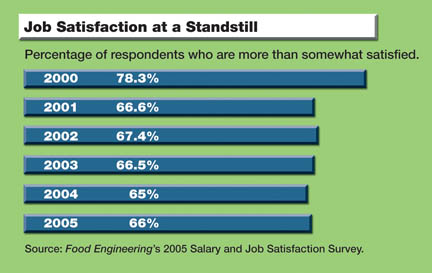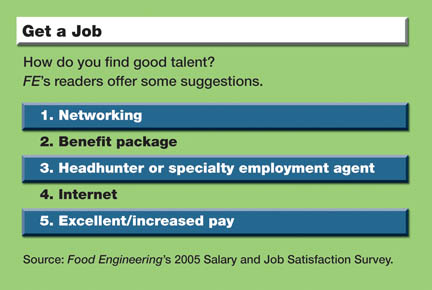25th Annual Salary & Job Satisfaction Survey: The Right Fit Improves Satisfaction
In some ways, it was a typical morning. The cashier was pleasant, the coffee was hot and the convenience store was abuzz with activity. The morning was cool and crisp, a typical autumnal day in the Northeast. It was then that I noticed a frazzled young man using a coffee stirrer to butter a bagel. The stirrer, which did a great job mixing coffee and cream, broke each time he tried to spread it across the bagel. And it occurred to me that people are a lot like coffee stirrers. When we do what we are designed to do, we perform well. But if we're put to work ineffectively, we break.
According to Food Engineering's 2005 Salary and Job Satisfaction Survey, it seems that some people in the food and beverage industry feel like the coffee stirrer. They are bent by increasing workloads that often crossover into areas outside of their interest or skill sets; workloads driven by demanding production goals. They are bent but many remain unbroken. In fact, satisfaction again hit the two-thirds mark this year, with 66 percent of respondents reporting they are more than somewhat satisfied with their jobs and salaries. This is a far cry from 2000, when total satisfaction topped out at 78 percent. For the last four years, the satisfaction rate has hovered around 65 percent with about 35 percent of respondents reporting they are dissatisfied or very dissatisfied, which begs the question, why? If one-third of respondents are consistently dissatisfied, what do they want?


To become more efficient, respondents identified more training, newer/upgraded equipment and additional staff as the top three actions employers can take. Technology, especially that which streamlines the data process, was mentioned by numerous respondents as another important factor. "[I need] tools such as automated downtime recording so that I have more accurate information that is easily accessible and can be used in decision making processes," said one respondent. However, companies should do their homework before purchasing some systems. "[My company needs to] make systems, SAP in particular, more effective. The idea of enterprise systems is to help us with our work, not be the work," noted one respondent.

Not crying uncle-yet
Satisfied or not, the majority of respondents face increased production with no additional help to complete the work (51 percent). Forty-one percent of companies directed employees to fill in the gaps and 25 percent increased production but took the extra step of adding new positions. Automation is, perhaps, helping to meet demand with nearly one-quarter of respondents noting that their companies have automated previously manual tasks. Since more than half of respondents are satisfied with their jobs and more than half are facing heavier workloads without additional help, it stands to reason that at least a few of those that are satisfied must also be working harder to meet these production goals. Perhaps they view their jobs as one "the glass-is-half-full-type" reader said, "...It is better to be working than not."But satisfaction is often tied to more than just having a job. Two-thirds of respondents received pay increases this year, with 52 percent receiving 3 percent increases or less. Another twenty-six percent saw their annual salary increase by 4 to 5 percent. Meanwhile, fewer and fewer respondents are receiving pay decreases. This year, just 2 percent of respondents lost money compared to 3 percent in 2004 and 7 percent in 2003. Overall, 43 percent of respondents earn between $60,000 and $99,999 per year.

Holding out for health care
As the nation ages, health care-the ability to get it and still have choices about it-are top concerns. According to the United States@Work report, "employees would prefer to have a greater choice in benefits than an increase in pay." Unfortunately, according to the report, companies often look to benefits as a way to reduce costs. "In recent years, escalating costs associated with providing these benefits have forced many organizations to search for more cost-effective ways to deliver employee benefits. Restructuring efforts have had consequences on how employees view their organizations-not all of these have been positive."Like the rest of the country, the food and beverage industry is feeling the benefits belt tighten. The second most requested action companies can take to make employees more satisfied was to improve the medical/benefit package, according to FE's survey. In fact, when asked what would be the most successful method of employee recruitment, respondents identified networking first with benefit packages ranking a close second. And not surprisingly, health care costs ranked among the top five most important workplace issues companies face today.

Calling all PR hounds
Anyone interested in taking on the challenge of increasing awareness about the food and beverage manufacturing industry to high school and college-age students? When asked to write-in suggestions for employee recruitment, respondents repeatedly identified a lack of awareness about the industry. As one respondent told us, "[We need] better marketing and education. I never knew about the many varied, interesting, fun yet challenging positions involved in this industry." Another wrote, "[We need] better PR focusing on aspects of the industry other than restaurant." And the issue of balance came up again as a way to recruit employees. "[We need to] present [them] with a balance-lifestyle, enjoyable work environment, competitive compensation, positive culture, community involvement and a livable location."
Who answered the survey?
A total of 542 people with a variety of job skills and positions responded to Food Engineering's 2005 Salary and Job Satisfaction Survey. Predominantly men (83%), the respondents included project engineers (12%), presidents (11%), plant managers (8%) and quality control managers (7%). Another 36 percent were fairly equally divided among R&D technical managers, vice presidents of operations, engineering managers, production supervisors, sanitation/maintenance managers, technical directors and operations directors.Respondents had an average of 20 years of experience in the industry and had worked for their current employers for about nine years. Further, more than two-thirds (66%) work for companies with more than one location, although both large and small corporations were represented. Twenty-nine percent of the companies have 5,000 or more employees; 8 percent had 2,500 to 4,999 employees; and 13 percent had 1,000 to 2,499 employees. One-quarter of the companies had fewer than 100 employees.
Looking for a reprint of this article?
From high-res PDFs to custom plaques, order your copy today!



